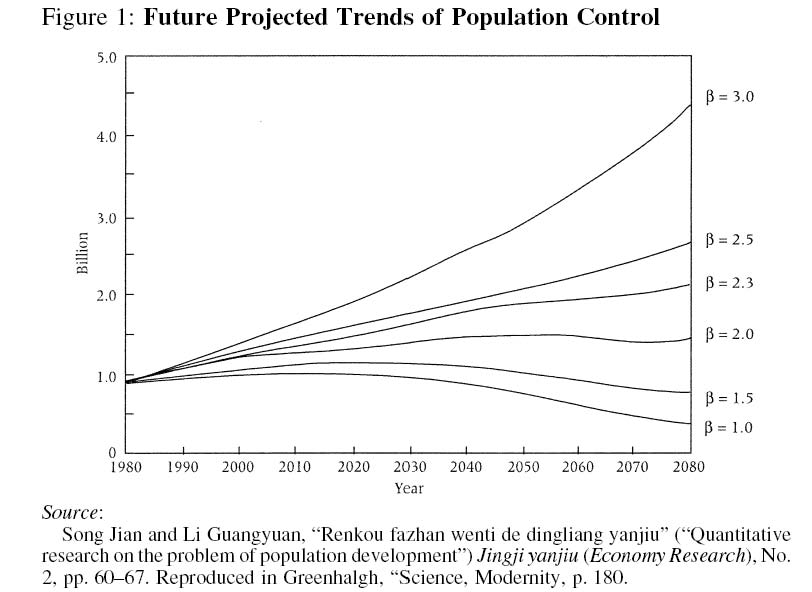中国“一胎化”政策的理论基础就是火箭专家宋健的《人口控制论》,所以很多人认为宋健是中国一胎化政策的设计者。其实不然,一胎化思想来自于当时的计委系统,当时由陈慕华秉承几位领导人的发言具体操办。而关键一步,就是宋健的工作进入陈慕华的视野、并被作为“科学依据”而采纳。而这个关键的一步,来自钱学森和经济学家许涤新的推荐。
见梁中堂《“一胎化”产生的时代背景研究(修改稿)》(代为分段):
如果我们阅读一下1980年2月上旬钱学森和许涤新分别给陈慕华的信,以及陈慕华于该月月底的回复,就不难确信这样一个事实,即1980年2月以前,宋健以及宋健的研究还没有进入陈慕华的视野。1980年2月8日,十分欣赏宋健的钱学森给陈慕华写信说:
“陈慕华副总理:七机部二院副院长、我国自动化理论家宋健同志和其他几位同志把他们最近就我国人口所作预测和分析的结果寄我一份,并附信作了简要说明。我认为这是自然科学和技术科学进入社会科学领域,和社会科学工作者一道,共同解决国民经济问题的一个良好开端,应该支持。知道您领导这方面的工作,所以把全部材料转呈给您,供您参考。此致革命敬礼!钱学森1980年1月8日”。
许涤新致陈慕华副总理的信说:
“慕华副总理:宋健等四同志的关于我国人口百年发展预测和分析是我国自然科学工作者和社会科学工作者合作研究的可喜成果,对于我国制定人口政策和国民经济远景规划,有一定参考价值。我同钱学森同志一样,很重视这一预测和分析,也主张把全部材料呈送给您,以便您在考虑人口政策时,作为参考。此致敬礼!许涤新1980年2月10日”。
大约半个月之后,陈慕华复函说:
“钱学森、许涤新同志:你们送来的我国未来一百年人口发展趋势的资料很好,对制订我国人口政策很有参考价值,我已特报政治局。请你们代向宋健等同志致谢。陈慕华1980年2月25日”。
《宋健科学论文选集》,科学出版社1999年,第546页。
另外,Susan Greenhalgh“导弹科学,人口科学:中国一胎化政策的起源”(Missile Science, Population Science: The Origins of China’s One-Child Policy,The China Quarterly (2005), 182 : 253-276 Cambridge University Press)等文章有更详细的叙述:
Early on Song was singled out for praise and patronage by Qian Xuesen, the US-educated father of China’s space programme and top military science advisor to Mao and Premier Zhou Enlai.16 It was Qian who declared that it was Song, not he, who was the country’s leading control theory scientist. Qian showered the young Song with favoured opportunities for scientific advance. At Qian’s behest, Song was invited to head a new Control Theory Research Office in the Mathematics Institute of the Chinese Academy of Sciences, and chosen to co-author the revised edition of Qian’s two-volume Engineering Cybernetics, a bible for generations of Chinese defence scientists and engineers. Song’s abundant talent, technical accomplishments, and political patronage and savoir faire combined to propel him into the ranks of the topmost defence scientists and engineers. …
Building on personal ties forged in the defence science community, Song then began creating networks to deliver the proposal into the hands of the people who would matter. He created two chains of ties, one connecting him to top population policy makers, the other linking him to top political leaders.62 In the first, Song sent the group’s work to two of the nation’s top scientists, one natural and one social. Qian Xuesen (mentioned above) was one of the most influential natural scientists in the country, while Xu Dixin was one of China’s most eminent economists. Qian and Xu sent the materials on to Chen Muhua. Chen soon replied, writing that the projections were “very good” and “have great reference value” for policy-making, adding that she had “already prepared a special report for the Politburo.”63 In the second network, Song sent the materials to the secretary at the powerful National Defence Science Commission, who turned them over to Wang Zhen, vice-premier and member of the Politburo and Standing Committee of the Central Military Commission. Here Song seems to have been counting on his reputation as a leading missile expert, along with the prestige and political clout of defence scientists and policy-making bodies, to make his population policy the leading contender for adoption.
The strategy seems to have worked. In an interview, Song reported how Wang Zhen, upon receiving the research report, immediately picked up the phone and called to express his alarm.64 In his written reply, Wang endorsed the work as “extremely important” and suggested that it be made known to Chen Yun, second only to Deng in prestige and influence, and Hu Yaobang, secretary-general of the CCP.65 Many interviewees stressed that China’s top leaders were awestruck by the mathematics, shocked by the projections and convinced that a one-child policy was the only option. Song himself emphasized the fears those numbers created in the minds of China’s leaders. According to him, not only Wang Zhen but also Hu Qiaomu, Hu Yaobang and Hu Qili were shocked and persuaded by the report. Chen Muhua “decided on the one-child policy after reading the research report.”66 With only some exaggeration, another central actor maintained that “all the central leaders said the report was right.”67
下图就是宋健当时让领导人震惊的计算。

2009年11月3日 at 5:29 am
现在中国人口14亿,beta接近2.5?
2009年11月3日 at 6:25 am
回陈珂:现在总人口不到13.5亿。生育率是逐渐下降,由于人口增长的惯性,不能说他的哪个beta接近于真实值。具体各个年代的生育率,1980年代维持在2.1到2.8,1990年开始低于更替水平,1995年不到1.5,2000年下降到1.2-1.3。这些都是互相吻合的实际数据。
单从计算上讲,宋健对几个问题考虑错误:生育率的自发下降,人口惯性,人均寿命延长。他提到的中国更替水平生育率是2.14,也是致命错误。中国目前的更替生育率是在2.3,实际生育率远低于更替水平。
你看到现在中国人口接近于宋健“2.5”的数字,实际原因在于1980-1990年生育率仍然维持在2.0以上、近30年来人均寿命继续提高。绝不意味着这30年一直有那么高的生育率。
宋健的预测,靠人口总量这种“积分”形式看不明显。具体到历年人口增长、老龄化比例、劳动年龄人口比例,就能看出来了。宋健讲2020年前中国不会有老龄化问题,但是实际上1999年中国就已经进入老龄化社会。1980-1990年生育率维持在2.0以上,这阶段出生的人口是现在中国经济发展的基石。而1990年代、2000年代低生育率的祸患,要在2010年代和2020年代顺次显示出来。
2010年5月25日 at 9:25 am
我看到宋健的在人口控制论话是这样说的:根据1978年人口数据,计算得到中国更替水平生育率是2.16。
当然今天世代交替生育率可能大约2.3个孩子。主要性别差距太大了。
我对于世代交替生育率的看法。非专业,希望你的点评。
是什么是生育率?按照人口和地质学家amsel观点是:生育率是指平均每名妇女一生生育的子女数。
总和生育率是指一段时间全部育龄妇女平均每人生育的子女数。
“更替水平”的生育率,是一个临界值,只有达到这个临界值,所有妇女才能生出
足够的女儿,来保障这个社会的人口延续下去。
理论上,生育率高于更替水平,则人口会无限增加下去;低于更替水平,则会一直
减少、最后消失。
那么世代交替生育率与那些因素有关呢?
第一,首先是性别比例。不如如果中国就一个女子,那么生育率必须达到13.2亿人,才能可持续发展。
虽然人口学家以前计算出来的中国的世代交替生育率是2.16。但是当时男女比例是属于正常的107:100。因此
考到目前性别比例是5:4(121:100)。中国世代交替生育必须修正达到2.16+(9/4-2)=2.41个孩子。
也就是有41%的家庭必须生3胎!
第二,人口死亡概率的影响。比如如果一个女孩没有等到她结婚生下2子之前,就亡故了。那么人口显然要减少。
考虑到现代医学的发展。这个数据时要减少的,当然上限是美国日本的医疗水平。因此世代交替率越来越接近2.1个孩子。
第三,不孕不育等生殖疾病的影响。考虑到现代社会高节奏,结婚偏迟。造成高龄产妇增多,无法完成生2胎的时间。因此人口自然也减少。
因此综上所述:我国世代交替生育率,如果不考虑性别的差距的话。应该在2.16左右。(死亡率和不孕不育作用相互抵消),但是考虑性别比例的话,我国数据应该是2.41个孩子左右。上下浮动0.05个孩子。
也就是我国生三胎比例必须达到40%!
2010年5月25日 at 11:23 am
回楼上:用不着崇拜。那些都是人口统计方面的书籍和文章的基本概念。计生委的很多数字都经不起推敲。有些人认为如今时代一旦停止计划生育还会人口膨胀,都是没动脑子的。